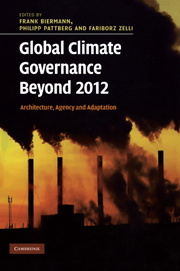Book contents
- Frontmatter
- Contents
- List of contributors
- Preface
- List of abbreviations
- 1 Global climate governance beyond 2012
- Part I Architecture
- Part II Agency
- Part III Adaptation
- 14 Global adaptation governance
- 15 Costs, benefits and interlinkages between adaptation and mitigation
- 16 Global adaptation governance
- 17 Global adaptation governance beyond 2012
- 18 Shaping future adaptation governance
- 19 Conclusions
- Index
- References
17 - Global adaptation governance beyond 2012
developing-country perspectives
Published online by Cambridge University Press: 05 July 2014
- Frontmatter
- Contents
- List of contributors
- Preface
- List of abbreviations
- 1 Global climate governance beyond 2012
- Part I Architecture
- Part II Agency
- Part III Adaptation
- 14 Global adaptation governance
- 15 Costs, benefits and interlinkages between adaptation and mitigation
- 16 Global adaptation governance
- 17 Global adaptation governance beyond 2012
- 18 Shaping future adaptation governance
- 19 Conclusions
- Index
- References
Summary
Introduction
It became apparent in the most recent report of the Intergovernmental Panel on Climate Change (IPCC) that climate change impacts are already being felt (IPCC 2007) and that those most vulnerable to these impacts are the poorest communities within poor countries, notably in the small-island developing states, the least industrialized countries, and countries whose economies heavily rely on climate-sensitive activities, particularly in Africa (Huq and Ayers 2007; IPCC 2007: 9). Yet it is also apparent, as we lay out in this chapter, that climate governance under the United Nations Framework Convention on Climate Change (the ‘climate convention’) still fails to adequately address climate change adaptation needs in developing countries.
Adaptation to climate change describes the adjustment in natural or human systems in response to actual or expected climatic stimuli or their effects, which moderates harm or exploits beneficial opportunities (IPCC 2007). Adaptation is seen as one of two options for managing climate change; the other is mitigation, which involves the limiting of greenhouse gas emissions, particularly of carbon dioxide and methane. Although adaptation and mitigation are inherently linked in the climate system (the more effective mitigation is undertaken now, the less need for adaptation in the future), until very recently they have been viewed as separate or even competing policy options under the convention (Swart and Raes 2007). Mitigation has been treated as an issue for industrialized countries who hold the greatest responsibility for climate change, while adaptation is seen as a priority for developing countries where mitigation capacity is lower and vulnerability is high (Dodman et al. 2009). Adaptation has historically been seen as a marginal policy option, mitigation’s ‘poor cousin’ in the climate policy arena (Pielke et al. 2007).
- Type
- Chapter
- Information
- Global Climate Governance Beyond 2012Architecture, Agency and Adaptation, pp. 270 - 285Publisher: Cambridge University PressPrint publication year: 2010
References
- 8
- Cited by



